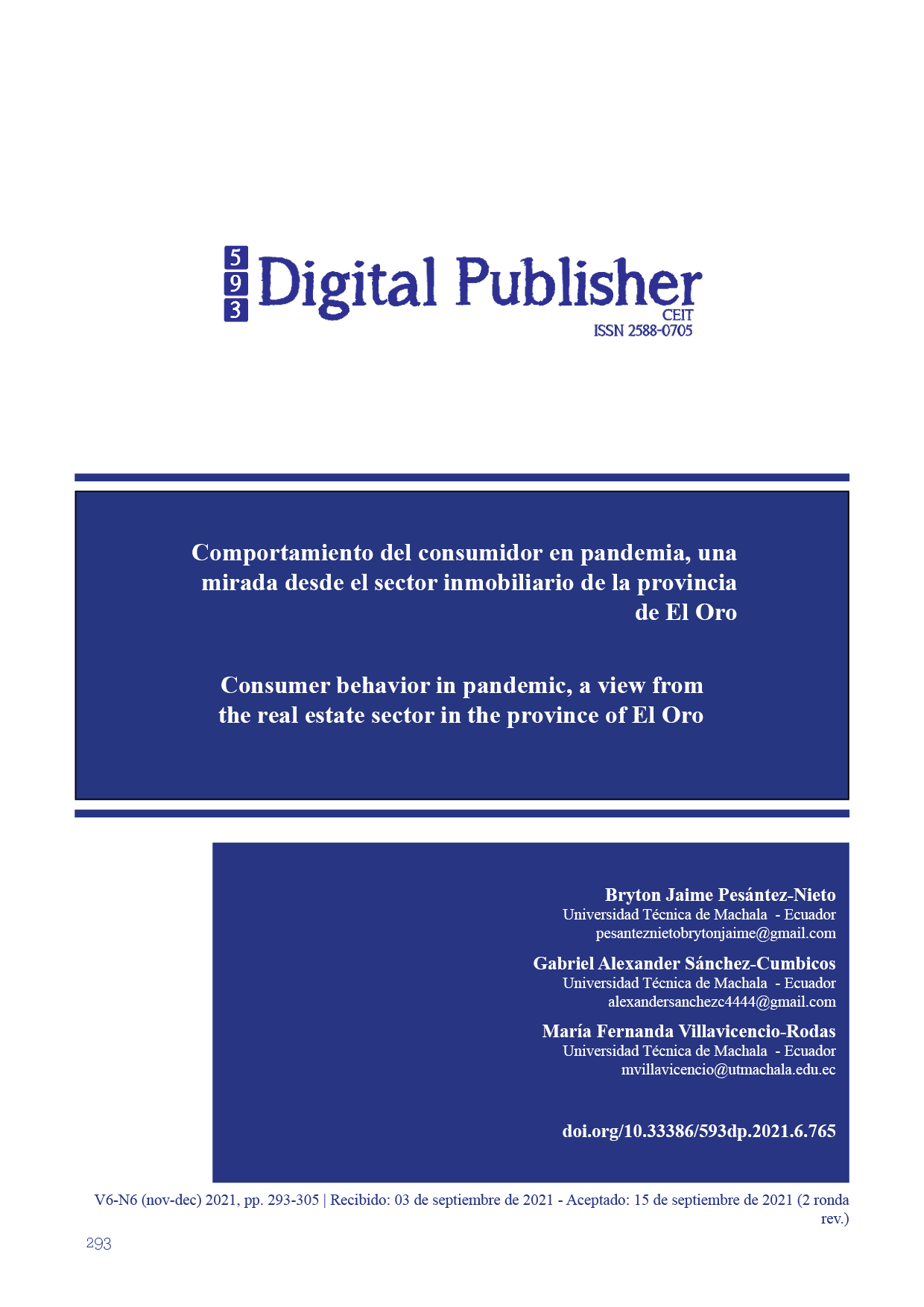Consumer behavior in pandemic, a view from the real estate sector in the province of El Oro
Main Article Content
Abstract
An article template and instructions on the editorial process and the text, figure and references format are provided. The objective of this research is to explore the behavior of the real estate consumer in times of pandemic from the perspective of real estate companies, through the analysis of the literature on the Theory of Planned Behavior (TBP) and the application of structured interviews to their managers, with the purpose of understanding this behavior in a local context. A descriptive qualitative methodology was applied and seven companies in the real estate sector in the province of El Oro were selected to collect information on the variables that make up the TBP. The results indicate that consumer behavior is a consequence of external factors such as economic, mobility and distancing restrictions taken by governments during the pandemic; and internal consumer factors such as attitude, subjective norms, perceived behavioral control and behavioral intention. The research shows that attitude and subjective norms are relevant as an antecedent to intention; since, when consumers are insecure and do not have the support of family and friends, they have lower purchase intention, which affected consumer behavior and generated a decrease in sales in the real estate market. At the business level, this research contributes to the change of management perspective, as well as to the development of new marketing and advertising strategies. Establishing that the new strategies should consider the use of new technologies and the primary focus on the sentimental attachment with the buyer's family and friends.
Downloads
Article Details

This work is licensed under a Creative Commons Attribution-NonCommercial-ShareAlike 4.0 International License.
1. Derechos de autor
Las obras que se publican en 593 Digital Publisher CEIT están sujetas a los siguientes términos:
1.1. 593 Digital Publisher CEIT, conserva los derechos patrimoniales (copyright) de las obras publicadas, favorece y permite la reutilización de las mismas bajo la licencia Licencia Creative Commons 4.0 de Reconocimiento-NoComercial-CompartirIgual 4.0, por lo cual se pueden copiar, usar, difundir, transmitir y exponer públicamente, siempre que:
1.1.a. Se cite la autoría y fuente original de su publicación (revista, editorial, URL).
1.1.b. No se usen para fines comerciales u onerosos.
1.1.c. Se mencione la existencia y especificaciones de esta licencia de uso.
References
Ajzen, I. (1991). The theory of planned behavior. sciencedirect. Obtenido de https://www.sciencedirect.com/science/article/abs/pii/074959789190020T
Almeida Quezada, M., & Bordes García, A. (Enero de 2017). El comportamiento del consumidor en la compra de bienes inmuebles, repaso a la ley de herencia y plusvalía en Ecuador. El comportamiento del consumidor en la compra de bienes inmuebles, repaso a la ley de herencia y plusvalía en Ecuador. Guayaquil, Guayas, Ecuador. Obtenido de http://repositorio.uees.edu.ec/handle/123456789/1566
Al-Nahdi, T. S., & Ghazzawi, O. H. (2015). Behavioral Factors Affecting Real Estate Purchasing. International Journal of Business and Social Science. Obtenido de https://www.ijbssnet.com/journals/Vol_6_No_8_1_August_2015/14.pdf
Bordes Garcia, A., & Almeida Quezada, M. (2017). The consumer behavior in the purchase of real estate, a review of the law of inheritance and. Universidad Espíritu Santo. Obtenido de http://repositorio.uees.edu.ec/handle/123456789/1566
Cadena Iñiguez, P., Rendón Medel, R., Aguilar Ávila, J., Salinas Cruz, E., Rosario, F., & Sangerman Jarquín, D. (2017). Quantitative methods, qualitative methods or combination. s Científicas de América Latina, el Caribe, España y Portugal. Obtenido de https://www.redalyc.org/pdf/2631/263153520009.pdf
Casco, A. (2020). Efectos de la pandemia de COVID-19 en el comportamiento del. INNOVARE REVISTA DE CIENCIA Y TECNOLOGÍA. Obtenido de file:///C:/Users/Bryton/Downloads/10208-Texto%20del%20art%C3%ADculo-36938-2-10-20200910%20(1).pdf
Cedeño Leon, J., & Sánchez Erazo, A. (2020). The socioeconomic impact of Ecuador and its relationship with the International Monetary Fund during Covid-19. Journal of business and entrepreneurial. Obtenido de https://www.journalbusinesses.com/index.php/revista/article/view/169
Chia, J., & Harun, A. (2016). Understanding factors that influence house purchase intention among consumers in kota kinabalu: an application of buyer behavior model theory. Understanding factors that influence house purchase intention among consumers in kota kinabalu: an application of buyer behavior model theory. Revista de Gestión Tecnológica y Empresarial . Obtenido de https://publisher.uthm.edu.my/ojs/index.php/jtmb/article/view/1466
Chiatchoua, C., Lozano, C., & Durán, J. (julio de 2020). Análisis de los efectos del COVID-19 en la economía mexicana. Análisis de los efectos del COVID-19 en la economía mexicana. Mexico. Obtenido de http://52.226.65.210/index.php/recein/article/view/2683
Childers, T., & Rao, A. (1992). The Influence of Familial and Peer-Based Reference Groups on Consumer Decisions. Journal of Consumer Research. Obtenido de https://www.researchgate.net/publication/24098734_The_Influence_of_Familial_and_Peer-Based_Reference_Groups_on_Consumer_Decisions
Escudero Sánchez, C., & Cortez Suárez, L. (2017). Técnicas y métodos cualitativos para la investigación científica. UTMACH. Obtenido de https://universoabierto.org/2020/10/01/tecnicas-y-metodos-cualitativos-para-la-investigacion-cientifica/
Gálvez, E. J., Guauña, R. A., & Pérez, R. I. (2018). Impact of subjective social norm in an intent to sustainable entrepreneurship: a case study with Colombian students. EAN. doi:10.21158/01208160.n85.2018.2048
Giantari, I. G., Zain, D., Rahayu, M., & Solimun. (2013). The role of perceived behavioral control and trust as mediator of experience on online purchasing intentions relationship a study on youths in denpasar city (indonesia). International Journal of Business and Management Invention. Obtenido de https://www.ijbmi.org/papers/Vol(2)1/Version_3/D213038.pdf
Guamán Guevara, M., Paredes-de la Cruz I, J., & Llivisaca Moreno, M. (2021). Digital marketing during times of COVID-19 in the commercial sector: case Pichincha- Ecuador. Polo del conocimiento.
Guzmán Facundo, F., García Salas, B., Rodríguez Aguilar, L., & Alonso Castillo, M. (2014). Attitude, Subjective Norm, and Behavioral Control as Predictors of Drug Use among Youth in Marginal Urban Area of Northern Mexico. scielo. Obtenido de http://www.scielo.org.mx/scielo.php?script=sci_arttext&pid=S0187-73722014000100003
Guzmán Facundo, F., Llamas Estrada, M., Rodríguez Aguilar, L., & Alonso Castillo, M. (2012). SUBJECTIVE NORM, INTENTION AND CONSUMPTION OF MARIJUANA IN COLLEGE STUDENTS OF MÉXICO. Scielo. Obtenido de https://scielo.conicyt.cl/scielo.php?script=sci_arttext&pid=S0717-95532012000100006
Heetae, Y., Hwansoo, L., & Hangjung, Z. (2017). User acceptance of smart home services: an extension of the theory of planned behavior. Emerald Insight.
Hoekstra, J., & Leefang, P. (2020). Marketing in the era of COVID19. Italian Journal of Marketing. Obtenido de https://link.springer.com/article/10.1007/s43039-020-00016-3
Hoyos Estrada, S., & Sastoque Gomez, J. (2020). Marketing Digital como oportunidad de digitalización de las PYMES en Colombia en tiempo del Covid – 19. Marketing Digital como oportunidad de digitalización de las PYMES en Colombia en tiempo del Covid – 19. Colombia: Revista CientíficaANFIBIOS. Obtenido de http://www.revistaanfibios.org/ojs/index.php/afb/article/view/60/62
Joong Kim, Y., Njite, D., & Hancer, M. (2013). Anticipated emotion in consumers’ intentions to select eco-friendly restaurants: Augmenting the theory of planned behavior. International Journal of Hospitality Management. Obtenido de https://www.sciencedirect.com/science/article/abs/pii/S0278431913000510
LABRADOR , H., SUAREZ, J., & SUAREZ, S. (2020). Marketing en tiempos de crisis generado por la COVID-19. espacios. Obtenido de https://www.revistaespacios.com/a20v41n42/a20v41n42p17.pdf
Labrador, H. E., Suarez, J. J., & Suarez, S. A. (2020). Marketing en tiempos de crisis generado por la COVID-19. Espacios. Obtenido de https://revistaespacios.com/a20v41n42/a20v41n42p17.pdf
Lizandro, A., Sabando, M., & Arteaga, H. (2016). Organizational behavior and its importance for business administration. Dominio de ciencias. Obtenido de https://www.dominiodelasciencias.com/ojs/index.php/es/article/view/275
López Piñón, D., & Terán Cázares, M. (2018). Validación de un instrumento para medir la intención de compra. Validación de un instrumento para medir la intención de compra. Obtenido de http://www.web.facpya.uanl.mx/Vinculategica/Vincultagieca_4/49%20LOPEZ_TERAN.pdf
Manrrique, V., Plaza, J., & Pacheco, A. (2019). Factores que ingluyen en el comprador al momento de adquirir un inmueble. Digital publisher. Obtenido de https://www.593dp.com/index.php/593_Digital_Publisher/article/view/137/407
Mark, C., & Christopher, A. (1998). Extending the Theory of Planned Behavior: A Review and Avenues for Further Research. Journal of Applied Social Psychology.
Martínez González, J. (2012). EL CARÁCTER CIENTÍFICO DEL MARKETING Y DEL ESTUDIO. Universidad de La Laguna. Obtenido de https://www.eumed.net/ce/2012/jamg.pdf
Raiteri, M., & Ocaña, H. (2016). El comportamiento del consumidor actual. El comportamiento del consumidor actual. Obtenido de https://videla-rivero.bdigital.uncu.edu.ar/objetos_digitales/8046/raiteri-melisa-daniela.pdf
Regalado Pezúa, O., Guerrero Medina, C., & Montalvo Corzo, R. (2017). Una aplicación de la teoría del comportamiento. Revista EAN. Obtenido de http://www.scielo.org.co/pdf/ean/n83/0120-8160-ean-83-00141.pdf
Regalado Pezúa, O., Guerrero Medina, C., & Montalvo Corzo, R. (2017). Una aplicación de la teoría del comportamiento planificado al segmento masculino latinoamericano de productos de cuidado personal. Revista EAN. Obtenido de https://journal.universidadean.edu.co/index.php/Revista/article/view/1821/1701
Reyes Rodriguez, L. (2007). La teoria de accion razonada: implicacion para el estudio de las actitudes. Ined. Obtenido de https://www.dspace.espol.edu.ec/handle/123456789/1836
Rojo Gutiérrez, M. A., & Bonilla, D. M. (2020). COVID-19: La necesidad de un cambio de paradigma económico y social. CienciAméRica. doi:10.33210
Sampedro, I., Laviada, A., & Crespo , Á. (2013). Aplicación de la teoría de la acción razonada al ámbito emprendedor en un contexto universitario. investigaciones regionales. Obtenido de https://www.redalyc.org/pdf/289/28928246007.pdf
Sánchez, M., & Gómez, B. (2014). In-depth interview as a pedagogical resource in Social Work and Social Education. Potentialities and challenges for theoretical and practical learning. Revista de Investigación en Educación. Obtenido de http://reined.webs.uvigo.es/index.php/reined/article/view/272
Sang, P., Yao, Y., Zhang, L., Wang, S., Wang, Y., & Liu, J. (2019). Influencing factors of consumers’ willingness to purchase green housing: a survey from Shandong Province, China. Springer Nature. Obtenido de https://link.springer.com/article/10.1007/s10668-019-00383-8
Sangkakoon, P., Ngarmyarn, A., & Panichpathom, S. (2014). The Influence of Group References in Home Purchase Intention in Thailand. Thammasat Business School. Obtenido de https://eres.architexturez.net/system/files/pdf/eres2014_191.content.pdf
Schiffman, L., & Kanuk, L. (2010). Comportamiento del consumidor. Comportamiento del consumidor. pearson. Obtenido de https://www.academia.edu/6116556/Comportamiento_del_Consumidor_Schiffman_10a_Ed
Shing Cheung, K., Yim Yiu, C., & Xiong, C. (2021). Housing Market in the Time of Pandemic: A Price Gradient Analysis from the COVID-19 Epicentre in China. Risk and financial management. Obtenido de https://www.mdpi.com/1911-8074/14/3/108/pdf




